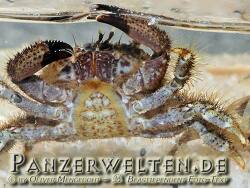am 19.01.15#4
Hallo,
ich habe diese Krabbe mit meinem Lebendgestein bekommen. Wie schon von garnele123 geschrieben lebt sie sehr versteckt. Am Anfang sieht man Sie nur sehr selten, aber nach einiger Zeit traut Sie sich vorzugsweise währen der Dämmerung etwas weiter aus ihrem versteck.
Dabei bewegt sie sich sehr langsam und bleibt vorzugsweise im dunkeln, sie lässt dabei meistens nur die Scheren ins helle ragen.
Merkt die Krabbe das sie entdeckt wurde, sprintet Sie sofort in Deckung wenn sie sich nicht sicher fühlt, wenn sie sich hingegen sicher fühlt, stellt sie jede Bewegung ein bis die Gefahr vorüber ist. Auf ihren Erkundungstouren kratz Sie unaufhörlich am Lebendgestein oder Sand und frisst die Algen davon. Da sie momentan noch alleine im Becken ist, kann ich über übergriffe nichts berichten ich gehe jedoch davon aus das sie sich nur von Algen ernährt. Da das Algenangebot im Becken sehr groß ist, füttere ich sie zur Zeit auch nicht weiter. Grüße
am 24.10.11#3
ich habe es endlich geschaft diese krabbe zu filmen!
hier ein video:
www.youtube.com
am 13.09.11#2
eine sehr friedlische krabbe, die die ganze zeit nur steine abkratzt.







 BEASTIEPENDENT
BEASTIEPENDENT

























